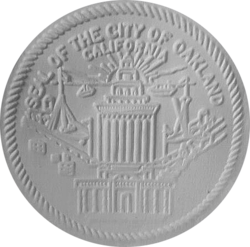Oakland CA: Difference between revisions
Created page with "{{Infobox municipality |municipality= City |established = May 4, 1852 |image = OAKLAND, CA, USA - Skyline and Bridge.JPG |image_caption = Oakland skyline |image_seal = Seal of..." |
No edit summary |
||
| Line 1: | Line 1: | ||
{{Infobox municipality | {{Infobox municipality | ||
|image=OaklandSkyline.jpg | |||
|image_caption=Oakland skyline | |||
|image = | |image_seal=Seal of Oakland, California.png | ||
|image_caption = Oakland skyline | |municipality=City | ||
|image_seal = Seal of Oakland, California.png | |established=May 4, 1852 | ||
|area = 78.03 | |area=78.03 | ||
|elevation = 43 | |elevation=43 | ||
|population = 440646 | |population=440646 | ||
|website = https://www.oaklandca.gov/ | |website=https://www.oaklandca.gov/ | ||
|timezone = PST | |timezone=PST | ||
|description= | |description=Oakland is the largest city and the county seat of Alameda County, California. A major West Coast port, Oakland is the largest city in the East Bay region of the San Francisco Bay Area, the third largest city overall in the San Francisco Bay Area, the eighth most populated city in California, and the 45th most populated city in the United States. With a population of 440,646 as of 2020, it serves as a trade center for the San Francisco Bay Area; the Port of Oakland is the busiest port in the San Francisco Bay, the entirety of Northern California, and the fifth busiest in the United States of America.[18] An act to incorporate the city was passed on May 4, 1852, and incorporation was later approved on March 25, 1854. Oakland is a charter city. | ||
Oakland is the largest city and the county seat of Alameda County, California. A major West Coast port, Oakland is the largest city in the East Bay region of the San Francisco Bay Area, the third largest city overall in the San Francisco Bay Area, the eighth most populated city in California, and the 45th most populated city in the United States. With a population of 440,646 as of 2020, it serves as a trade center for the San Francisco Bay Area; the Port of Oakland is the busiest port in the San Francisco Bay, the entirety of Northern California, and the fifth busiest in the United States of America.[18] An act to incorporate the city was passed on May 4, 1852, and incorporation was later approved on March 25, 1854. Oakland is a charter city. | |||
}} | }} | ||
Latest revision as of 07:01, April 6, 2022
- Members
Oakland is the largest city and the county seat of Alameda County, California. A major West Coast port, Oakland is the largest city in the East Bay region of the San Francisco Bay Area, the third largest city overall in the San Francisco Bay Area, the eighth most populated city in California, and the 45th most populated city in the United States. With a population of 440,646 as of 2020, it serves as a trade center for the San Francisco Bay Area; the Port of Oakland is the busiest port in the San Francisco Bay, the entirety of Northern California, and the fifth busiest in the United States of America.[18] An act to incorporate the city was passed on May 4, 1852, and incorporation was later approved on March 25, 1854. Oakland is a charter city.
Activities

|
Augmented Neighborhood Watch | |
# Engage with Constituents currently part of the City of Oakland NCPCs to keep an eye and report crime to their local police Beat Officers. Present IoT Kits to the NCPCs to invest in micro-grid infrastructure kits that include mesh networks, computer vision cameras, sensors, and secure communication channels to capture live data about events happening to community homes, block by block. Install series of “Capture” hardware devices and send this data to a secure data platform per kit owner.
| ||

|
Constituent-led Public Data and IoT Utility for Urban Health Housing and Environmental Hazard Management | |
Objectives
| ||

|
Oakland 100% electric school bus fleet | |
| The Oakland Unified School District, in collaboration with Zum and utility provider PG&E, has achieved a groundbreaking milestone by transitioning to a 100% electric school bus system with vehicle-to-grid (V2G) technology. This initiative, the first of its kind in the US, involves a fleet of 74 electric buses equipped with bidirectional chargers managed through Zum's AI-enabled platform. By becoming emissions-free and serving as a Virtual Power Plant (VPP), this fleet not only addresses environmental concerns but also contributes 2.1 gigawatt hours (GWh) of energy back to the grid annually. This transformative project not only benefits the Oakland community but also sets a precedent for other districts, with plans to electrify school bus fleets in San Francisco and Los Angeles next. | ||

|
Smart City Vision Strategic Planning and Digital Transformation Methodology | |
* The Smart City methodology helps people imagine and learn about future state scenarios for their lives, businesses, and cities. The process produces clearly defined product solutions and projects they want to create, design, and implement.
| ||





